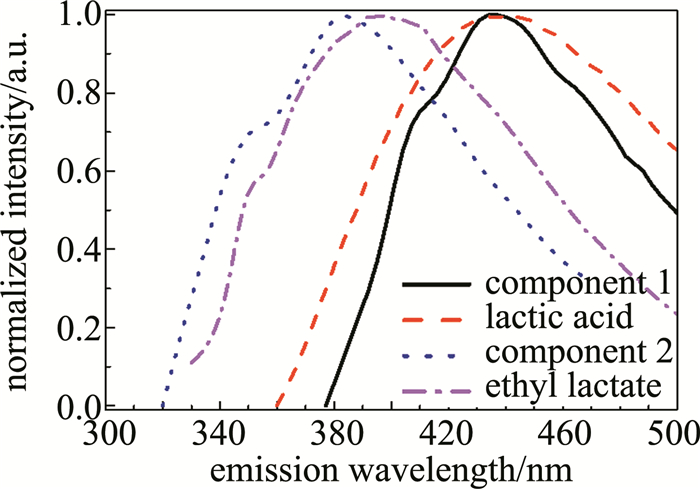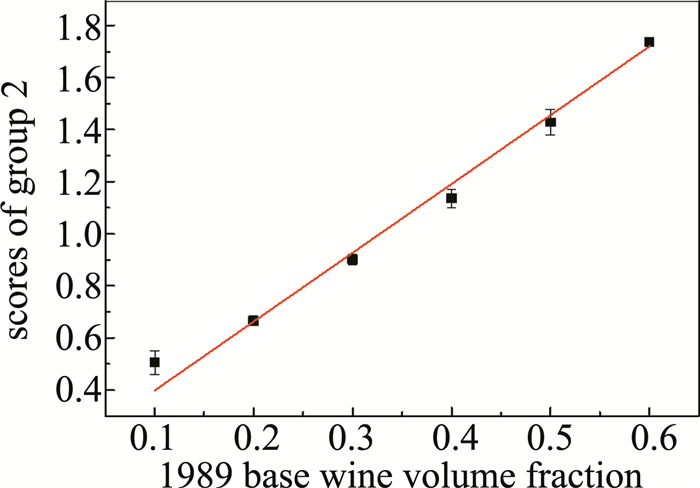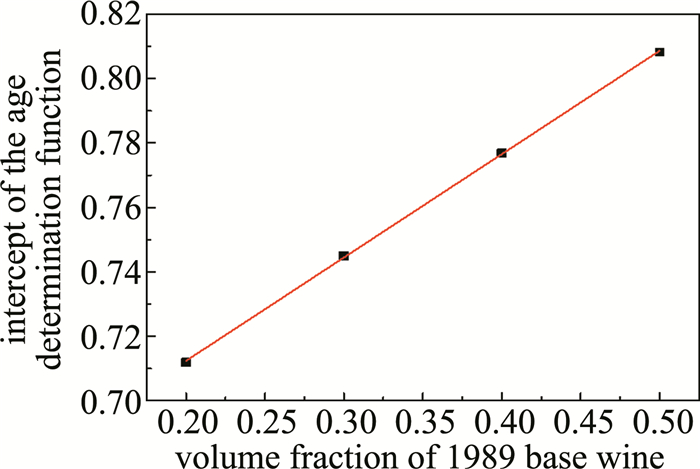HTML
-
白酒是中国传统蒸馏酒的统称,具有悠久的发展历史和丰富的文化内涵。对白酒的研究和检测一直是社会关注的话题[1]。白酒品牌繁多,可通过风味特点、制造技术、发酵剂类型进行分类[2-3]。白酒本身成分也比较复杂,主要成分为乙醇和水,体积分数约为0.97,此外还有体积分数约为0.03的酯类、酸类、醛类等数百种微量成分[4-5]。此外,白酒在贮存过程中会发生一系列理化反应,使得成分变化[6-7]。这些因素导致了白酒检测的困难性。
白酒在酿造之初,口感辛辣,而在贮存的过程中,物质含量发生改变,口感逐渐醇厚柔和[8]。年份无疑是影响白酒品质和价格的重要因素。根据中国酒业协会发布的白酒年份酒团体标准[9],白酒年份酒是由贮存3年及3年以上的几种基酒勾调而成的中高端白酒。在白酒年份酒检测的研究中,ZHANG等人通过荧光寿命法测定年份酒的年份[10];WANG等人使用喇曼光谱结合支持向量机回归测定年份[11]。光谱结合算法对白酒年份酒进行年份测定具有可行性[12-13]。目前对年份酒的检测多针对年份进行,较少涉及年份酒中基酒使用量的研究,无法有效解决白酒年份酒市场上存在的高年份基酒使用量不足、以次充好的问题,存在一定的局限性。对于白酒年份酒,除准确测定年份之外,高年份基酒的使用量也值得关注。
3维荧光光谱上每个点对应激发波长、发射波长和荧光强度,包含了丰富的物质光谱信息,在白酒等复杂混合物体系的分析中具有广泛的应用[14-15]。GU等人通过白酒的3维荧光光谱结合小波分解与因子分析对白酒的年份进行鉴别[16]。ZHU等人基于量子遗传算法和3维荧光光谱对某清香型白酒进行年份预测[17]。3维荧光光谱结合数学方法,可有效预测白酒的年份。本文作者利用白酒年份酒的3维荧光光谱,结合平行因子算法和光谱相似度算法,提出了一种年份酒检测方法。通过平行因子分析算法,解析出年份酒中高年份基酒的特征荧光基团,从而计算出年份酒中高年份基酒的体积分数。在此基础上,结合光谱相似度算法,推导出年份预测函数,测定白酒年份酒的年份。本文中提出的检测方法,解决了3种基酒配制年份酒的检测问题,可准确识别年份酒中高年份基酒的体积分数,并具有较高的年份测定精度。
-
实验仪器为稳态和时间分辨荧光光谱仪(英国Edinburgh FLS920P),其光谱可测量波长范围为200 nm~900 nm,分辨率可至0.1 nm。FLS920P光谱仪配备450 W氙灯作为激发光源,信噪比为6000 ∶1。20 ℃环境温度下进行实验,设置光谱采集参数激发波长250 nm~500 nm,步距为5 nm,发射波长260 nm~600 nm,步距为2 nm。
以某品牌白酒为例,在不加入任何其它物质的条件下,选择该品牌于1989年、2004年和2014年生产的基酒,将这3种基酒按不同的比例混合配制成年份酒样本。乳酸和乳酸乙酯等单体物质采购自国家标准物质中心。
-
平行因子算法是由KIERS等人[18]提出的,可用于多成分混合物的分析中[19-20]。该算法基于交替最小二乘原理实现多维数据矩阵分解。3维荧光光谱数据集包含I个激发波长,J个发射波长,K个样本,组成I×J×K的矩阵X (大小为I×J×K),三线性模型表示为:
式中,N表示分解的组分数;$ \otimes$表示张量积;an、bn、cn分别表示第n个组分的激发光谱矩阵、发射光谱矩阵、浓度矩阵;E为3维残差矩阵。
-
为比较不同白酒的相似程度,提出的一种定量计算两个3维荧光光谱相似程度的算法。首先使用下式对白酒3维荧光光谱进行平滑处理:
式中,f(x,y)代表平滑后的白酒3维荧光光谱,xi,yi,zi分别表示发射波长、激发波长和对应的荧光强度,均为实测数据。基于平滑的3维荧光光谱,两个3维荧光光谱的相似度S通过以下公式进行计算:
式中,Ω为积分区域;两个3维荧光光谱f1(x,y)和f2(x,y)经过归一化处理后相减,再积分,得到两光谱差异部分的值D,这个值介于0~2之间。D的值由两个3维荧光光谱各贡献一半,所以两光谱相同部分的值,即光谱相似度,通过(4)式计算。S的值介于0 ~ 1之间,越接近于1,表明两光谱越相似。
1.1. 仪器与样本
1.2. 数据处理方法
1.2.1. 平行因子算法
1.2.2. 光谱相似度算法
-
实验测得某品牌白酒于1989年、2004年、2014年生产的基酒和三者混合配制的16年年份酒(体积分数分别为:1989年基酒0.20,2004年基酒0.30,2014年基酒0.50)的3维荧光光谱,如图 1a~图 1d所示,其荧光光谱特征参数值如表 1所示。年份酒的年份指的是3种基酒加权平均酒龄,通过下式进行计算:
sample effective excitation wavelength range/nm optimum excitation wavelength/nm peak fluorescence wavelength/nm peak fluorescence intensity/a.u. 1989 base wine 250~410 300 358 507376 2004 base wine 300~420 365 444 119408 2014 base wine 300~420 365 442 49953 16-year aged Baijiu 300~420 360 438 127626 Table 1. Eigenvalues of 3-D fluorescence spectra of base and the aged Baijiu
式中,Y为年份酒标注年份,Y1~Y3为生产为1989年、2004年和2014年基酒的酒龄,φ1~φ3为这3种基酒的体积分数。
1989年基酒的荧光峰位于激发300 nm,发射360 nm处,而2004年基酒与2014年基酒位于激发370 nm,发射450 nm附近。3种基酒的光谱存在相似性,其中2004年基酒与2014年基酒的光谱相似程度较高。同时3种基酒的荧光强度也有明显差别,1989年基酒贮存时间相对较长,其荧光光谱与另两种基酒的荧光光谱差异明显。
年份酒由3种基酒混合配制而成,其荧光光谱与3种基酒的荧光光谱存在相似性,但荧光强度不满足3种基酒荧光强度的线性叠加的结果。因为白酒的成分复杂,不同年份生产的基酒主要荧光物质存在差异,不同荧光物质分子的荧光效率不同。此外,荧光分子之间缔和形成团簇也会造成影响[21-22]。考虑到不同荧光分子的发光效率和荧光物质间的缔和作用,不能通过简单的基酒光谱叠加得到年份酒光谱。
-
通过对酒样光谱的分析,高年份基酒与低年份基酒的3维荧光光谱存在差异。因为白酒在贮存过程中,主要的荧光物质因一系列理化反应而变化,即高年份基酒相比其它两种基酒存在特征荧光物质。利用平行因子分析对年份酒3维荧光光谱进行解析,获得与高年份基酒的特征荧光物质相对应的组分,以及该组分对年份酒3维荧光光谱的贡献(组分得分)。通过高年份基酒特征荧光物质对应组分的得分,计算得到年份酒中高年份基酒的体积分数。
根据高年份基酒的体积分数,配制24个年份酒样本,并测量3维荧光光谱。将这24个样本的光谱数据分为训练集和测试集,其中训练集包括18个年份酒光谱数据,测试集包括6个年份酒光谱数据,具体配样方式如表 2所示。
training set sample volume fraction training set sample volume fraction testing set sample volume fraction 1989 base wine 2004 base wine 2014 base wine 1989 base wine 2004 base wine 2014 base wine 1989 base wine 2004 base wine 2014 base wine 1 0.10 0.20 0.70 10 0.40 0.15 0.45 1 0.20 0.30 0.50 2 0.10 0.40 0.50 11 0.40 0.35 0.25 2 0.20 0.60 0.20 3 0.10 0.60 0.30 12 0.40 0.45 0.15 3 0.30 0.15 0.55 4 0.20 0.35 0.45 13 0.50 0.15 0.35 4 0.30 0.25 0.45 5 0.20 0.40 0.40 14 0.50 0.25 0.25 5 0.40 0.25 0.35 6 0.20 0.50 0.30 15 0.50 0.40 0.10 6 0.50 0.10 0.40 7 0.30 0.10 0.60 16 0.60 0.10 0.30 8 0.30 0.20 0.50 17 0.60 0.20 0.20 9 0.30 0.30 0.40 18 0.60 0.30 0.10 Table 2. Sampling ratio of samples used for parallel factor analysis
将24个样品的光谱数据组成3维荧光光谱数据矩阵(大小为29×116×24),通过平行因子分析对该数据矩阵进行解析。选择2组分模型分解24个年份酒光谱数据,得到2个组分的相对荧光强度,如图 2所示。组分1的发射光谱峰值波长为440 nm,组分2的发射光谱峰值波长为375 nm。平行因子分解得到的组分可与溶液中荧光物质相对应,对比白酒中常见荧光物质的光谱,乳酸和乳酸乙酯的光谱可较好地对应组分1和组分2的光谱。而这两种物质的光谱未能和两组分光谱完全重合的原因分析是由于白酒存在其他荧光物质的干扰。

Figure 2. Comparison of the fluorescence emission spectra of the two components obtained by parallel factor analysis with the fluorescence emission spectra of lactic acid and ethyl lactate
训练集结果如图 3所示。组分2得分和1989年基酒体积分数存在高度相关性。实验结果表明,年份酒中1989年基酒体积分数越高,组分2得分越高,表明该基酒中组分2对应的乳酸乙酯含量越高,符合白酒在贮存过程中因酯化反应而带来的酯类物质含量增加的现象。线性拟合训练集样本的组分2得分与1989年基酒体积分数,函数表达式为:
式中,G为组分2得分,φ1为1989年基酒体积分数,决定系数R2=0.99,线性度良好。
测试集6个年份酒样本的组分2得分代入(6)式中,预测的年份酒中1989年基酒体积分数如表 3所示。结果显示,平均回收率为100.28,通过平行因子算法可准确识别年份酒中高年份基酒的体积分数。
sample volume fraction of base wine the predicted volume fraction of 1989 base wine recovery rate/% 1989 base wine 2004 base wine 2014 base wine 1 0.20 0.30 0.50 0.2008 100.40 2 0.20 0.60 0.20 0.1932 96.60 3 0.30 0.15 0.55 0.2962 98.73 4 0.30 0.25 0.45 0.3147 104.90 5 0.40 0.25 0.35 0.3956 98.90 6 0.50 0.10 0.40 0.5106 102.12 average recovery rate — — — — 100.28±2.92 root mean square error of prediction — — — — 0.0082 Table 3. The predicted volume fraction and recovery of 1989 base wine
-
进一步为确定年份酒年份,引入光谱相似度算法对年份酒3维荧光光谱进行分析。使用26个年份酒样本,分为训练集和测试集。其中训练集包含20个年份酒样本,分为4组,每组5个样本,1989年基酒体积分数分别为0.2,0.3,0.4和0.5。测试集的6个样本与平行因子分析中测试集的6个样本相同。训练集具体的配样方式如表 4所示。
training set sample volume fraction training set sample volume fraction testing set sample volume fraction 1989 base wine 2004 base wine 2014 base wine 1989 base wine 2004 base wine 2014 base wine 1989 base wine 2004 base wine 2014 base wine 1 0.20 0.15 0.65 8 0.30 0.30 0.40 15 0.40 0.50 0.10 2 0.20 0.25 0.55 9 0.30 0.40 0.30 16 0.50 0.15 0.35 3 0.20 0.35 0.45 10 0.30 0.50 0.20 17 0.50 0.25 0.25 4 0.20 0.40 0.40 11 0.40 0.10 0.50 18 0.50 0.30 0.20 5 0.20 0.50 0.30 12 0.40 0.35 0.25 19 0.50 0.40 0.10 6 0.30 0.10 0.60 13 0.40 0.40 0.20 20 0.50 0.45 0.05 7 0.30 0.20 0.50 14 0.40 0.45 0.15 Table 4. Sampling ratio of training set samples used for spectral similarity algorithm analysis
通过相似度算法计算年份酒与1989年基酒的3维荧光光谱相似度S1,结果如图 4所示。1989年基酒体积分数相同的年份酒,其年份和S1存在高度相关性。且不同1989年基酒的体积分数的年份酒,拟合出的年份测定函数曲线相互平行。年份测定函数可表达为:
式中,Y为年份酒年份,T为年份测定函数的截距。T的值与年份酒中1989年基酒的体积分数存在线性关系,如图 5所示。拟合函数表示为:

Figure 5. The fitted relationship between intercept of the year determination function and 1989 base wine volume fraction
式中,φ1为1989年基酒体积分数,拟合函数决定系数为0.99。
-
对某待测年份酒酒样,测量其3维荧光光谱,通过平行因子分析得到组分2得分G,再通过光谱相似度算法,计算其与1989年基酒的3维荧光光谱相似度S1。组分2得分G代入(6)式中,得出该年份酒酒样中1989年基酒的体积分数φ1。1989年基酒体积分数φ1代入(8)式中,计算得到年份测定函数截距T,将T和S1代入(7)式中,计算得出该年份酒的年份。简而言之,通过(6)式~(8)式,得到某品牌白酒年份酒的年份测定公式:
测试集6个年份酒样本的测定结果如表 5所示。
sample true volume fraction of base wine forecast volume fraction of base wine true age/a forecast age/a error/a 1989 base wine 2004 base wine 2014 base wine 1989 base wine 2004 base wine 2014 base wine 1 0.20 0.30 0.50 0.2008 0.3180 0.4812 16.00 16.68 0.68 2 0.20 0.60 0.20 0.1932 0.5320 0.2748 19.00 18.61 0.39 3 0.30 0.15 0.55 0.2962 0.0765 0.6273 17.00 16.88 0.12 4 0.30 0.25 0.45 0.3147 0.1813 0.5040 18.00 18.43 0.43 5 0.40 0.25 0.35 0.3956 0.2350 0.3694 20.50 21.19 0.69 6 0.50 0.10 0.40 0.5106 0.1150 0.3744 21.50 21.88 0.38 Table 5. Age forecast results
测定年份误差不超过1年,平均误差仅为0.45年,测定高年份基酒的体积分数误差不超过0.02。对于3种基酒配制的年份酒,在测定出年份和高年份基酒体积分数的情况下,可推算其它两种基酒的体积分数。推算得出的两种低年份基酒体积分数误差不超过0.08。
2.1. 基酒与年份酒的3维荧光光谱
2.2. 算法结果
2.2.1. 平行因子分析结果
2.2.2. 光谱相似度计算过程
2.2.3. 年份预测结果
-
针对白酒年份酒光谱变化不规律,导致年份鉴别困难的问题,提出了基于3维荧光光谱,平行因子算法与光谱相似度算法相结合的分析方法。实验结果证明,通过平行因子算法可以预测年份酒中至少一种基酒的体积分数,光谱相似度算法则进一步预测出年份酒的年份。在解决年份酒年份预测问题的同时,预测年份酒中高年份基酒的体积分数。同时解决了白酒检测中两个重要的问题,为白酒年份酒的检测提供了一种分析方法和重要参考。

 Map
Map







 DownLoad:
DownLoad:



